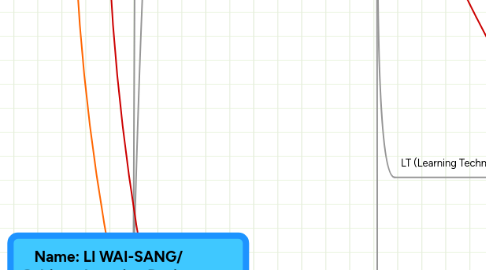
1. Learning Technology Project
1.1. Tools: flowchart, storyboard, prototype
1.1.1. Storyboard Development
1.1.1.1. Storyboard Evaluator
1.1.1.2. Design Specification
1.1.2. Prototype Development
1.1.2.1. Interface Design
1.1.2.1.1. User Interface (UI)
1.1.2.2. Presentation Design
1.1.2.3. Interaction Design
1.1.2.4. Prototype Evaluation
1.2. Learning outcome
1.2.1. Able explain more in sub-outcome
1.3. ADDIE process
1.3.1. stage1: analysis
1.3.1.1. Conduct analysis
1.3.1.2. Environmental Analysis
1.3.1.3. System Analysis
1.3.1.4. Audience Analysis
1.3.1.5. Content Analysis
1.3.1.6. Feasibility Analysis
1.3.1.7. Risk Assessment
1.3.2. stage2: design
1.3.2.1. Define Goal
1.3.2.2. Conduct Instructional Analysis
1.3.2.2.1. Task Analysis
1.3.2.3. Analysis Learner and Context
1.3.2.4. Learning Objective
1.3.2.5. Assessment
1.3.2.6. Develop Instructional Strategy
1.3.2.7. Arrange Instructional Event
1.3.2.8. Develop Flowchart and Storyboard
1.3.3. stage3: development
1.3.3.1. Outsourcing
1.3.3.2. In-house
1.3.3.3. Existing product enhancement
1.3.3.3.1. solution can buy resource or use opensource
1.3.4. stage4: implementation
1.3.4.1. Define software development life cycle (SDLC)
1.3.4.2. Define system development life cycle (SDLC also)
1.3.4.3. SDLC process
1.3.4.4. Pseudo code
1.3.4.4.1. IF...THEN... ELSE
1.3.4.4.2. Looping: WHILE...DO/ REPEAT...UNTIL/ FOR...NEXT/ SWITCH/SELECT...CASE
1.3.4.4.3. Variable Definition: Independent/ Dependent variable
1.3.4.4.4. Class definition: Public/ Private/ Protected
1.3.4.4.5. Object Definition: E-R diagram, call-flow
1.3.4.5. Identify product criteria is web-based, mobile-based or OS-based
1.3.4.5.1. Web-based platform runs on IIS/ Apache/ Tomcat web server engine plus which server platform: Unix/Linux-like, Windows?
1.3.4.5.2. Mobile-based platform runs on which mobile platform?
1.3.4.5.3. OS-based platform includes the application runs over operating system directly, such like a single application, e.g. the 'EXE', 'SISX' or 'Java apps'
1.3.4.6. Define coding tools based on above product criteria: C/C++, Visual Basic, C#, Java, PHP, MS.net ... etc
1.3.4.7. Define Data such as database structure, data storage, data reuse, data mining and data warehouse
1.3.4.8. Object-oriented programming design (OO approach)
1.3.5. stage5: evaluation
1.3.5.1. Questionnaire
1.3.5.2. Survey
1.3.5.3. Comments/ feedback/ response
1.3.5.4. By marking or ranking
1.3.5.5. Usage feeling
1.3.5.6. Social feedback
1.3.5.7. Statistical tools
1.4. LT (Learning Technology) Product
1.4.1. Educational Institute
1.4.1.1. Purpose: specific on education need
1.4.1.2. class ICT/ e-learning/ m-learning/ flexible learning/ blended learning/ distance learning ... etc
1.4.2. Commercial Environment
1.4.2.1. Purpose: specific on business training need
1.4.2.2. sales training/ e-training/ user manual/ client solution report ... etc
1.4.3. Four Component/ Instructional Design (4C/ID) model
1.4.4. M-learning
1.4.4.1. APPS development
1.4.4.1.1. Difficulties need make different APPS run on different platform
1.4.4.2. Platform: Android, Apple IOS, Blackberry, Samsung Bada, Symbian, HP WebOS, Winphone7
1.4.4.2.1. Different platform makes different market: androidmarket, appstore, ovi, winmarketplace
1.4.4.3. computer-supported collaborative learning
1.4.4.4. Limitation
1.4.4.4.1. Small-screen display
1.4.4.4.2. Bandwidth bottleneck limit network speed
1.4.4.4.3. Multiple platform needs developer design different APPS to fit the platform
1.4.4.4.4. Chinese/ Japanese/ Korean handwriting may difficult recognize
1.4.4.5. Anytime and anywhere can doing 'learning' activity via mobile device
1.4.5. E-learning
1.4.5.1. Educational website, multimedia learning platform
1.4.5.2. Digital Profolio
1.4.5.3. Learning Management System (LMS)
1.4.6. IEEE LT Technical Issue
1.4.7. Open Source/ Freeware
1.4.7.1. Free-of-charge
1.4.7.2. Free OS: Linux (debian, centos, fedora... etc)/ BSD/ Darwin
1.4.7.3. Free LMS: moodle ... etc
1.4.7.4. Many opensource can download and modify by the programmer or developer to get enhancement and improvement
1.4.8. Cloud computing
1.4.8.1. Network-based
1.4.8.2. Via internet/web
1.4.8.3. Anytime and anywhere can access via web browser
1.4.8.4. Free-of-charge
1.4.8.5. Data or object storage on server-side
1.4.8.6. Reduce client-side resource
1.4.8.6.1. Cut Software cost, license fee
1.4.8.6.2. Reduce Hardware cost
1.4.8.7. Reusable objects
1.4.8.8. Able to use through mobile-device or any computer system, only need network access plus web browsing
1.4.8.9. Shortage
1.5. Instruction Design and Event
1.5.1. Instructional Event organize a set of communication to students
1.5.1.1. Communication channel make up a instruction set to aid learning process
1.5.2. Event makes an action of Learning process
1.5.2.1. 1.Attention 2.Selective perception 3.Rehearsal 4.Semantic encoding 5.Retrieval 6.Response organization 7.Feedback 8.Executive control process
1.5.2.1.1. Stimulation: learning through practice into memory by learning process
1.5.3. First Generation Instructional Design (ID1)
1.5.3.1. Limitation of ID1 occurs, thus it needs 'Second Generation Instructional Design (ID2)'
1.5.3.1.1. Second Generation Instructional Design (ID2)
1.5.4. Knowledge representation, KR
1.5.4.1. Knowledge analysis and acquisition system.(KAAS)
1.5.4.1.1. Knowledge Objects
1.5.4.1.2. Knowledge Interrelationships
1.5.5. Instructional Design Theory
1.5.5.1. Algorithms vs. frame-based instruction
1.5.5.2. Computer program assumption
1.5.6. Reusable Learning Object (RLO, sometimes called a Shareable Content Object)
1.5.6.1. CISCO RIO Strategy
1.5.6.2. Learning Objects
1.5.6.2.1. Metadata
1.5.6.2.2. XML schema
1.5.6.2.3. RSS feed
1.5.6.3. Digital Audio Learning Object (DALO)
2. Learning Theories
2.1. Constructivism
2.1.1. web 2.0 maybe useful for information sharing
2.1.1.1. web2.0 technology: blog/ podcast/ social networking/ interactive game/ audio-video AV
2.1.1.2. learning tools
2.1.2. web searching maybe needed by learner
2.1.2.1. social networking/bookmarking: facebook, twitter, delicious, msn
2.1.3. Learner is active in the learning processes
2.1.4. Multimedia design in a constructivist framework
2.2. Cognitivism
2.2.1. memorization always needed
2.2.2. a traditional way of teaching in HK
2.2.3. Presenter is the knowledge transferer
2.2.4. learners are passive in getting information
2.3. Behaviorism
2.3.1. Larger room is needed for activities
2.3.2. more suitable for active students
2.3.3. Experimental base learning
2.3.4. Project assessment based
2.3.5. more interactive between teacher and students
2.4. Learning Model
2.4.1. Learning-By-Doing Model
2.4.1.1. Kolb Learning Cycle Model
2.4.2. Jonassen’s Constructivist Learning Model
2.4.2.1. Jonassen's Learning Environment
2.4.3. Multimedia Learning Model
2.5. Active Learning
2.5.1. Rich Environment for Active Learning (REAL)
